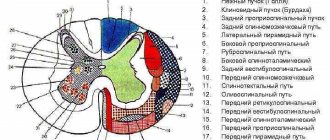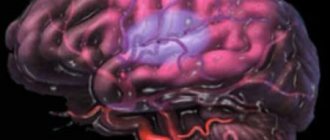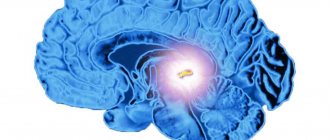Impaired sensitivity is a condition in which the neural network located deep in the epidermis and subcutaneous fat layer cannot adequately perceive, process, or transmit nerve impulses to the structures of the brain. As a result, a person gets the impression that the sensitivity of the limbs or other parts of the body is impaired. The condition is often accompanied by numbness and decreased muscle tone. A local decrease in temperature and pallor of the color of the epidermis may be observed. This is due to the fact that when the autonomic nervous system is disrupted, the tone of the blood vessels is negatively affected.
Sensory impairment syndrome most often occurs against the background of long-term diseases of the musculoskeletal system, such as osteochondrosis, protrusion and intervertebral hernia, spondylosis, tunnel syndromes (carpal, carpal valve, cubital, brachial, piriformis, etc.).
You can learn more about potential causes of sensory impairment and effective and safe treatment on this page.
If you periodically experience a feeling of loss of sensitivity in one or another part of the body, you need to see an experienced neurologist as soon as possible. This doctor will be able to make an accurate diagnosis through examinations and diagnostic functional tests. He will then develop an individual course of treatment. In Moscow, you can make an appointment for a free appointment with a neurologist at our manual therapy clinic. We employ experienced doctors who can provide medical care to the required extent.
Causes of impaired sensitivity in hands and feet
A sudden loss of sensation in the legs or arms is an alarming sign in which the development of a cerebral stroke or spinal canal stenosis cannot be ruled out. But more often in practice, less dangerous causes of impaired sensitivity in the hands are identified, which can consist of both a physiological temporary limitation of blood flow and developing diseases of the musculoskeletal system and the autonomic nervous system.
The main causes of sensitivity disorders are:
- damage to the peripheral and central nervous system (for example, due to poisoning with salts of heavy metals);
- traumatic effects on the structures of the brain and spinal cord (concussions, bruises, dislocation, fractures of vertebral bodies with displacement and entrapment of the dural membrane, etc.);
- malignant and benign neoplasms in the brain, spinal canal;
- disruption of the blood supply to the brain and spinal cord (may be ischemic or hemorrhagic);
- iron deficiency anemia, in which the number of red blood cells decreases and secondary oxygen starvation of brain structures is observed;
- diabetic angiopathy and neuropathy - due to the fact that with constant changes in blood sugar levels, the body cannot adequately regulate insulin production and the functioning of the vascular wall and neural network is disrupted;
- atherosclerotic damage to the inner wall of large and medium-sized blood vessels, leading to a decrease in the intensity of blood flow;
- infectious damage to the autonomic nervous system;
- osteochondrosis, complicated by protrusion and intervertebral hernia with radicular syndrome, leading to pinched nerve fiber;
- instability of position and displacement of the vertebral bodies in the form of retrolisthesis and antelesthesis;
- poor posture and curvature of the spinal column;
- spondylosis, spondyloarthrosis and vertebral subluxations;
- tunnel syndromes (carpal, carpal, cubital, pyriform, etc.);
- poisoning with salts of heavy metals and certain medications;
- alcohol and drug intoxication and withdrawal syndrome;
- deficiency of certain vitamins (mainly group B) and minerals in the peripheral blood;
- violation of the integrity of the conductive nerve network (for example, with deep cuts, gunshot and knife wounds);
- complications of the early postoperative period.
This is not a complete list of reasons for which there is a violation of the sensitivity of the hands and feet. Only an experienced neurologist can exclude all risk factors during the initial history collection.
PREFACE
Clinical diagnosis plays a central role in making a neurological diagnosis. Underestimation of its data and imperfect clinical knowledge very often lead to medical errors. The largest number of them is associated with insufficiently careful neurological examination, as well as with incorrect assessment and interpretation of clinical examination data. Recent years have been marked by the introduction into widespread clinical practice of new highly informative methods for instrumental diagnosis of diseases of the nervous system. But even the most modern of them should be considered as additional when establishing a diagnosis, which is important for neurologists to constantly remember. Only a comprehensive and comprehensive diagnosis of nervous diseases, based on modern clinical knowledge, allows us to give a reliable answer to the question of the adequacy of the choice and correctly evaluate the results of auxiliary research techniques. All this demonstrates the undeniable importance of improving clinical knowledge and was the main reason for the creation of this book.
In 1997, the Department of Nervous Diseases of the Military Medical Academy named after. S. M. Kirova published the first domestic guide to the differential diagnosis of diseases of the nervous system, which has now gone through four editions and has become a reference book on clinical diagnostics in neurology for many doctors. Nevertheless, the expediency of publishing new books on this issue is obvious, which is reflected in the release of this guide. Its advantages, in our opinion, include division into chapters according to the syndromological principle, clear structuring of the material, detailed description of a large number of informative neurological symptoms and syndromes, constant correlation of the clinical picture of neurological syndromes and their characteristic nosological forms. In accordance with the syndromological approach, most chapters are structured as follows: basic information about the clinical neuroanatomy of the corresponding structures of the nervous system, anatomical and functional characteristics of these structures and their individual components, neurological symptoms of their damage, analysis of syndromic and other criteria for clinical diagnosis for the main nosological forms.
The proposed guidelines can be considered as a definite result of the clinical and research work of the authors and a number of department employees. In addition, the book includes a number of materials from now classic textbooks and monographs, as well as data published in domestic and foreign neurological literature in recent years, for which we express our gratitude and gratitude to its authors. We hope that the contents of the manual, the tables and illustrative material presented in it will provide a compelling reason for reading and studying this book.
The authors express special gratitude to the staff of the Department of Nervous Diseases of the Military Medical Academy named after. S. M. Kirov, who was directly involved in writing a number of chapters of this manual.
The spelling of Latin terms and their Russian translations are given in accordance with international anatomical terminology edited by Corresponding Member of the Russian Academy of Medical Sciences L. L. Kolesnikov, published in 2003. Eponymous terms used in the manual are given in accordance with the reference book “Eponyms in Medicine” (St. Petersburg .: Hippocrates, 2001).
Types, types and levels of sensory impairment
There are different types of sensory impairment, which differ in the level of damage to the nerve fiber and the localization of the pathological process. When exclusively distant nerve endings are affected, the peripheral type develops. There are also cortical or cerebral types of sensitivity disorders, the cause of which is a disruption in the functioning of analyzers in the structures of the brain.
Levels of sensitivity impairment are differentiation of the depth of the lesion depending on the patient’s sensations. Thus, at the first or remote level, only the nerve endings in the fingers or toes are affected. At the second level, numbness extends into the hand or foot like socks or gloves. The third level of sensory loss may affect the limbs up to the elbow or knee. At the fourth level, the sensitivity of the entire affected limb is impaired. At this stage, muscle strength usually decreases, tremors and other signs of total neuropathy may appear.
Next, we will consider individual types of sensory impairment of the upper and lower extremities.
Sensitivity disorder of conduction type
Violation of conductive sensitivity is an interruption of the chain of transmission of nerve impulses at the level of the spinal cord. There may be a conduction-type sensitivity disorder in osteochondrosis with compression of the radicular nerve. Also, conduction sensitivity disorders occur with stenosis of the spinal canal, displacement of vertebral bodies, inflammation of the dural membranes, etc.
It is important to understand that disorders of deep sensitivity occur on the affected side. For example, if the radicular nerve in the cervical spine on the right side is subjected to compression, then a deep sensitivity disorder will be detected on the right limb. And the left hand will suffer from numbness and superficial paresthesia.
Impaired tactile (skin) sensitivity
Any violation of tactile sensitivity requires a thorough diagnosis of the condition of the brain and spinal cord. If skin sensitivity is impaired, the patient complains that he does not feel cold and heat, cannot determine the structure and consistency of a substance by touch, etc.
Impaired skin sensitivity often occurs when certain branches extending from the nerve plexus are compressed. For example, if the tactile sensitivity of the fingers decreases, compression of the median and radial nerves should be excluded. If the skin sensitivity of the forearm decreases, it is important to carefully diagnose the condition of the ulnar nerve, etc.
Socks and gloves type impairment of peripheral sensitivity
Impairment of peripheral sensitivity can develop according to the neural, polyneuritic or distal type. If a certain nerve is affected, a neural sensitivity disorder of the lower extremities or arms develops. With multiple lesions of nerve fibers, a total decrease in sensitivity develops.
Thus, with polyneuropathy, sensory disturbances like socks and gloves often develop. If such signs appear, you should immediately consult a doctor. This condition may indicate a violation of cerebral circulation, the development of diabetic or toxic neuropathy, etc.
Segmental type of sensitivity disorder
Segmental sensory loss can occur with degenerative damage to the spinal cord structures. The dorsal roots and horns, nodes of the spinal nerve plexuses, and fibers of the white commissure are often affected. The segmental type of sensory impairment is always accompanied by pain and loss of a number of reflexes, which is easily diagnosed by an experienced neurologist during the initial examination.
There is also a cortical type of sensitivity disorder. It occurs when the cerebral cortex is damaged. With it, there are cramps in the arms and legs, and epileptic seizures often appear. May develop in persons who abuse alcoholic beverages.
Brown-Séquard syndrome
Brown-Séquard syndrome is characteristic of unilateral spinal cord lesions. On the affected side below its level there is spastic paresis (damage to the descending corticospinal tract after its transition to the side of the peripheral motor neuron) - in combination with loss of deep sensitivity; on the other side there is loss of superficial sensitivity. This picture occurs, in particular, with extramedullary tumors, especially neuromas originating from the roots of the spinal cord (Fig. 1.3.7).
Loss of sensation in fingers and toes
In some cases, impaired sensitivity of the fingers may be associated with the development of Raynaud's syndrome. This is angiotrophoneurosis, in which remote areas of arterioles are affected and the distal sections of the upper and lower extremities cease to receive a sufficient amount of blood. This is accompanied by a feeling of numbness.
But in most cases, impaired sensitivity of the fingers is associated with the development of carpal tunnel syndrome. Or carpal valve syndrome may develop. Numbness is accompanied by a decrease in muscle tone and severe pain that occurs in the evening. Pathology often occurs in people who work at a computer.
Loss of sensitivity in the toes can occur due to a number of pathologies:
- flat feet and club feet with compression of the nerve fiber;
- hallux valgus or varus deformity of the foot;
- deforming osteoarthritis of small joints of the foot;
- compression of the plantar, tibial or peroneal nerves;
- diabetic angiopathy and neuropathy;
- vascular pathologies, such as obliterating endarteritis (mainly occurs in men aged 30–35 years), varicose veins of the lower extremities (mainly develops in women of childbearing age during pregnancy), atherosclerosis.
Impaired sensitivity of the foot may be a sign of radicular syndrome against the background of lumbosacral osteochondrosis. It is possible that the sciatic nerve is damaged in piriformis syndrome and the development of a number of other pathologies.
Preobrazhensky syndrome
In other cases, one can encounter combinations of severe bilateral pyramidal symptoms (usually from the lower extremities) with pelvic disorders and bilateral conduction disorders of surface sensitivity. This is typical for acute or chronic insufficiency of spinal circulation (Preobrazhensky syndrome), since in the spinal cord there is an anterior area of blood circulation (anterior and lateral cords, where, in particular, the motor corticospinal tract and the tract of surface sensitivity - spinothalamic) and predominantly posterior (lateral and posterior cords, the latter causing deep sensitivity). Material from the site https://wiki-med.com
Symptoms and signs of sensory impairment
At first glance, everything is obvious here and the patient must accurately determine the signs of sensory impairment in one or another part of the body. But there is a high danger of inadequate assessment of one’s condition. Sensory impairment may be accompanied by characteristic symptoms:
- feeling of crawling sensations;
- tingling and burning sensation;
- electric current discharges;
- decreased muscle strength.
All these symptoms of sensory impairment allow a more accurate diagnosis to be made and appropriate treatment to be prescribed. Sometimes sensory impairment manifests itself in unexpected ways. For example, a person picks up a hot object and does not feel the heat. But burns remain on the skin. If this situation occurs to you, immediately consult a neurologist.










